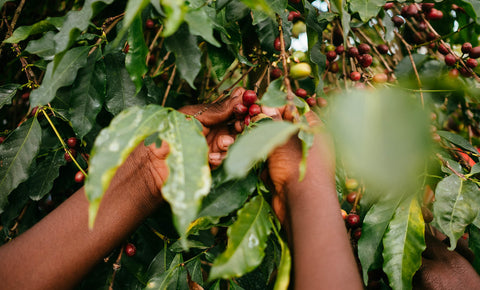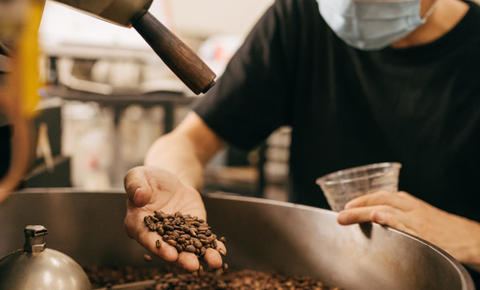“To me, the smell of fresh-made coffee is one of the greatest inventions.”- Hugh Jackman
Coffee is a lifestyle—a morning ritual, a midday boost, and a way to connect with loved ones. Walking into a cafe, one can easily come across terms such as “single origin” and “blends”, but what do these terms actually mean, and which is the right bean for you?

What Does Single Origin Mean?
In the coffee world, "single origin" means the product comes from one specific region and can be traced back to its exact source. These coffees typically exhibit characteristics of their terroir, which include soil and climate conditions. Examples of single origin coffees include generic labels such as “Ethiopian Coffee”, or more specific ones naming the farms or collectives where the coffee is grown, such as Bom Jardim, which is grown by members of the San Coffee collective from the Minas Gerais region of Brazil.
Touted as coffee in its “purest form”, single origin’s flavour profiles differ greatly, and vary depending on the region where they are grown. From varietals, soil and water, to climate and processing methods, there are several factors that may influence the flavours of a single origin to make it unique to the region. Similar to wine, single origin beans may display flavour notes of chocolate and nuts, to complex flavours ranging across the entire fruit spectrum of stone fruit, tropical, berries and citrus. They also display unique body types and acidity levels, offering complex taste profiles that showcase the terroir of the region, or the “flavour” of the land.
Single Origin by Region
A region could encompass an entire country, or a single state or province, and the soil composition, rainfall, and microclimates within the region dictate the flavours prominent in a single origin coffee. In Ethiopian coffees for example, Jabanto from the Yirgacheffe region in Ethiopia is created from the Kurume, Dega, and Wolisho varietals, and features a more fruity taste profile of grapes, guava and blueberries, while Anferara from the Anferara, Masina region is crafted from a single 74110 varietal and features a more floral note with hints of maple syrup and blueberries. Despite being grown at similar altitudes, both single origins differ in taste, yet still carry a slight resemblance in flavour profiles due to the proximity of their growing locations within the same region.

Single Origin by Farms /Collectives
Choosing beans provided by a single farm or collective narrows down the flavour profiles, and ensures a high quality standard in the growing, harvesting, and processing of beans as small-scale coffee farmers are known to tend to their crops with the utmost care and attention to detail. The perfect example of a smallholder coffee is Okalu, crafted from the Typica and Arusha varietals by smallholder farmers in the Lufa and Okapa Eastern Highlands province of Papua New Guinea. Boasting notes of red currant and maple syrup with a lingering dark chocolate aftertaste, these beans yield a balanced, medium-bodied brew that captivates drinkers with a floral aroma and crisp medium-level acidity.
In short, single origins are usually seasonal; while they offer a sensory journey connecting us to specific regions and the people behind them, their availability largely depends on the harvest season in their region of origin. In contrast, blends are crafted through experimentation, aiming to consistently deliver a defined taste profile for those who prefer the same coffee blend throughout the year.
The Beauty of Coffee Blends
Unlike single origin coffees, blends usually incorporate a combination of two or more single origins, possibly from different regions around the world. While this does not allow the consumer to savour the basic characteristics of each varietal, a great blend is able to create new flavour profiles and allows for the roaster to showcase the potentials that each single origin coffee would not be able to achieve on its own. The idea is to create a smooth, well-balanced coffee that encompasses the best qualities from each origin, while maintaining a more consistent flavour profile that is not as widely affected by seasonal variations as that of a single origin.

While generic blends are widely available, most coffee roasters will also offer signature blends that are designed to work well as an espresso with a distinct flavour profile in focus. Blends are unique in their own way when combining multiple flavour profiles from different regions, and are a wonderful way of showcasing the skill and creativity of a professional roaster. When done skillfully, roasters are able to even out uneven taste profiles caused by blending beans of different roast levels, ultimately creating a delicious well-balanced brew suitable for anyone, and everyone.
In cases where a single origin is not able to fully meet the expectations of a drinker - for instance, if a fan of nutty coffee aromas finds a Brazilian single origin’s flavour profile to be too simple - a bold chocolatey and nutty option blending the Brazilian with a single origin Guatemalan may be the answer. A perfect pairing for milk-based coffee beverages, nearly all coffee roasters carry a similar variation of this flavour profile, which is ubiquitous today amongst the ever-evolving specialty coffee cafe scene.

For others who may instead prefer their coffee with a hint of acidity, but find a single origin Ethiopian to be too bright, a blend of Brazilian, Ethiopian and Colombian single origins would showcase a diversity of fruit flavours with hints of sweetness to chocolatey and floral notes. Although coffees are seasonal, and composition changes are inevitable depending on seasonality and availability, each single origin’s dominant flavour profile usually prevails and the results would not vary too greatly when blended.






